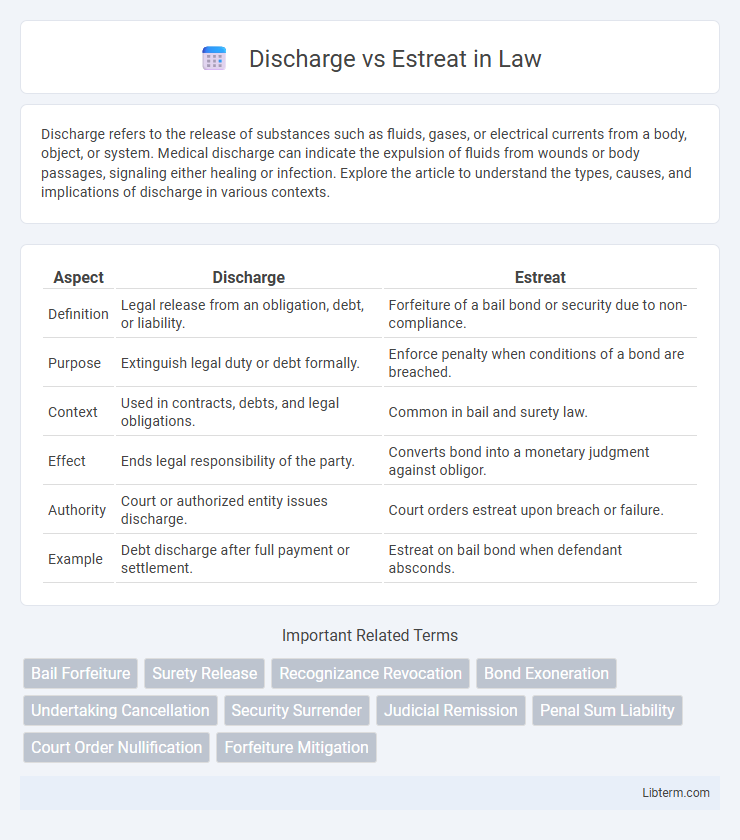Discharge refers to the release of substances such as fluids, gases, or electrical currents from a body, object, or system. Medical discharge can indicate the expulsion of fluids from wounds or body passages, signaling either healing or infection. Explore the article to understand the types, causes, and implications of discharge in various contexts.
Table of Comparison
| Aspect | Discharge | Estreat |
|---|---|---|
| Definition | Legal release from an obligation, debt, or liability. | Forfeiture of a bail bond or security due to non-compliance. |
| Purpose | Extinguish legal duty or debt formally. | Enforce penalty when conditions of a bond are breached. |
| Context | Used in contracts, debts, and legal obligations. | Common in bail and surety law. |
| Effect | Ends legal responsibility of the party. | Converts bond into a monetary judgment against obligor. |
| Authority | Court or authorized entity issues discharge. | Court orders estreat upon breach or failure. |
| Example | Debt discharge after full payment or settlement. | Estreat on bail bond when defendant absconds. |
Understanding Discharge and Estreat: Key Definitions
Discharge refers to the release of a party from a legal obligation upon fulfilling contractual or court-ordered requirements, while estreat is the process of enforcing a forfeiture of a bond or surety after a party fails to meet those obligations. Understanding discharge involves recognizing the completion of duties that terminates liability, whereas estreat involves the collection of penalties by converting a bond into money due to a breach. These terms are crucial in contract law and surety practices, highlighting the outcomes of compliance versus non-compliance.
Legal Context: When Are Discharges and Estreats Applied?
Discharges in a legal context typically occur when a party fulfills their obligations under a bond or court order, resulting in the release from liability. Estreats are applied when a bond is forfeited due to non-compliance, leading the court to demand payment of the bond amount. Courts use discharges to formally close a case or obligation, while estreats serve to enforce compliance through financial penalties.
Differences Between Discharge and Estreat
Discharge refers to the formal release or completion of an obligation, such as a debt or bond, indicating that the terms have been fulfilled. Estreat involves the process of converting a bond or security into a forfeiture, typically due to non-compliance or breach of conditions, leading to enforcement of penalties. The key difference lies in discharge representing the end of liability, while estreat signifies the enforcement action taken because of a default.
Core Criteria for Discharge in Legal Cases
Discharge in legal cases primarily requires the fulfillment of all court-imposed conditions, including payment of fines, completion of community service, or compliance with probation terms, ensuring the defendant meets the court's requirements. Estreat, by contrast, involves the forfeiture of a bond when the defendant fails to meet these conditions. Core criteria for discharge emphasize the defendant's adherence to legal obligations and the court's satisfaction that justice has been served without the need for further penalties.
Conditions Leading to Estreat Procedures
Estreat procedures are initiated when the conditions of a bond or guarantee, such as court-ordered payments or compliance requirements, are breached or unfulfilled. Failure to meet these contractual obligations triggers the estreat process, leading to the forfeiture of the deposited amount or surety. Discharge occurs only after all stipulated conditions are satisfied, resulting in the formal release of bond responsibilities.
Financial Implications: Discharge vs Estreat
Discharge releases a party from financial liability, eliminating any further obligation to pay a bond or security deposit. Estreat involves forfeiture of the bond or deposit, resulting in immediate financial loss to the principal due to failure to meet contractual or legal conditions. Understanding the financial implications of discharge versus estreat is crucial for risk management in surety agreements and loan guarantees.
Effects on Defendants: Rights and Consequences
Discharge releases defendants from their obligations, restoring rights and ending legal liabilities associated with the case. Estreat involves forfeiting bonds or deposits, resulting in financial penalties and potential restrictions on defendants' rights. These differing outcomes significantly impact defendants' legal standing and future obligations.
Discharge and Estreat in Criminal vs. Civil Law
Discharge in criminal law refers to the release of a defendant from further obligation after charges are dropped or a case is resolved, while in civil law, it denotes the termination of liability or obligation under a contract or judgment. Estreat involves enforcing forfeiture of a bond or surety, commonly seen in criminal cases to ensure compliance with bail conditions, whereas in civil law, estreat pertains to converting a judgment bond into a collectible debt. The key distinction lies in discharge ending a party's legal duty, whereas estreat enforces penalties or financial obligations through formal legal processes.
Recent Legal Developments: Discharge and Estreat Trends
Recent legal developments in discharge and estreat focus on tightening regulatory frameworks to prevent abuse of estreat procedures, ensuring estreats are executed only when financial guarantees or bonds are forfeited due to non-compliance. Courts have emphasized clearer standards for discharge, prioritizing timely resolution and reducing prolonged liabilities for defendants. Trends indicate a shift toward digital tracking systems for estreat processes to enhance transparency and efficiency in enforcement actions.
Frequently Asked Questions: Discharge vs Estreat
Discharge refers to the formal release from a financial or legal obligation, often used in contexts such as bond release or debt settlement, while estreat involves the enforcement and collection of a penalty or bond forfeiture by a court or authority. Frequently asked questions about discharge vs estreat include their differences in legal consequences, procedures for bond removal, and situations warranting estreatment. Understanding the distinct roles and processes helps clarify liability status and ensures proper compliance with judicial or contractual requirements.
Discharge Infographic

 libterm.com
libterm.com